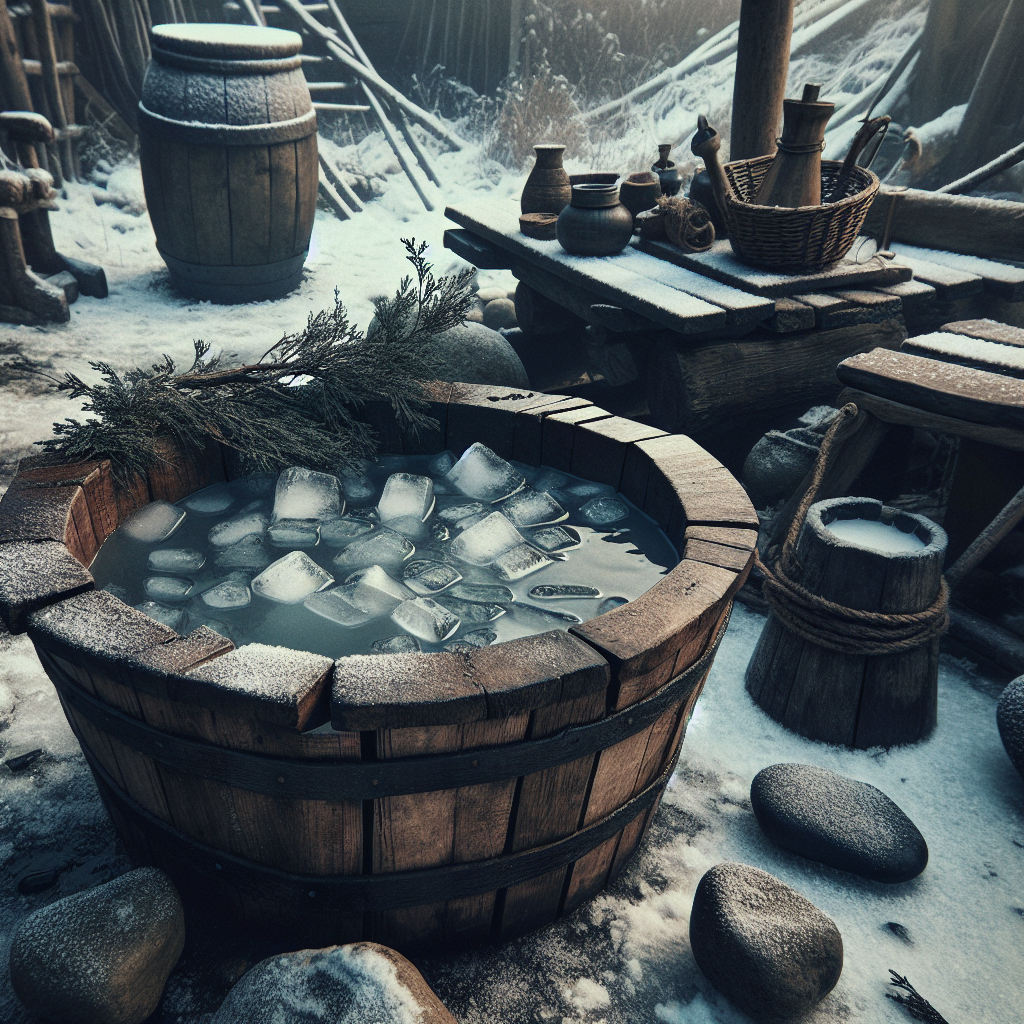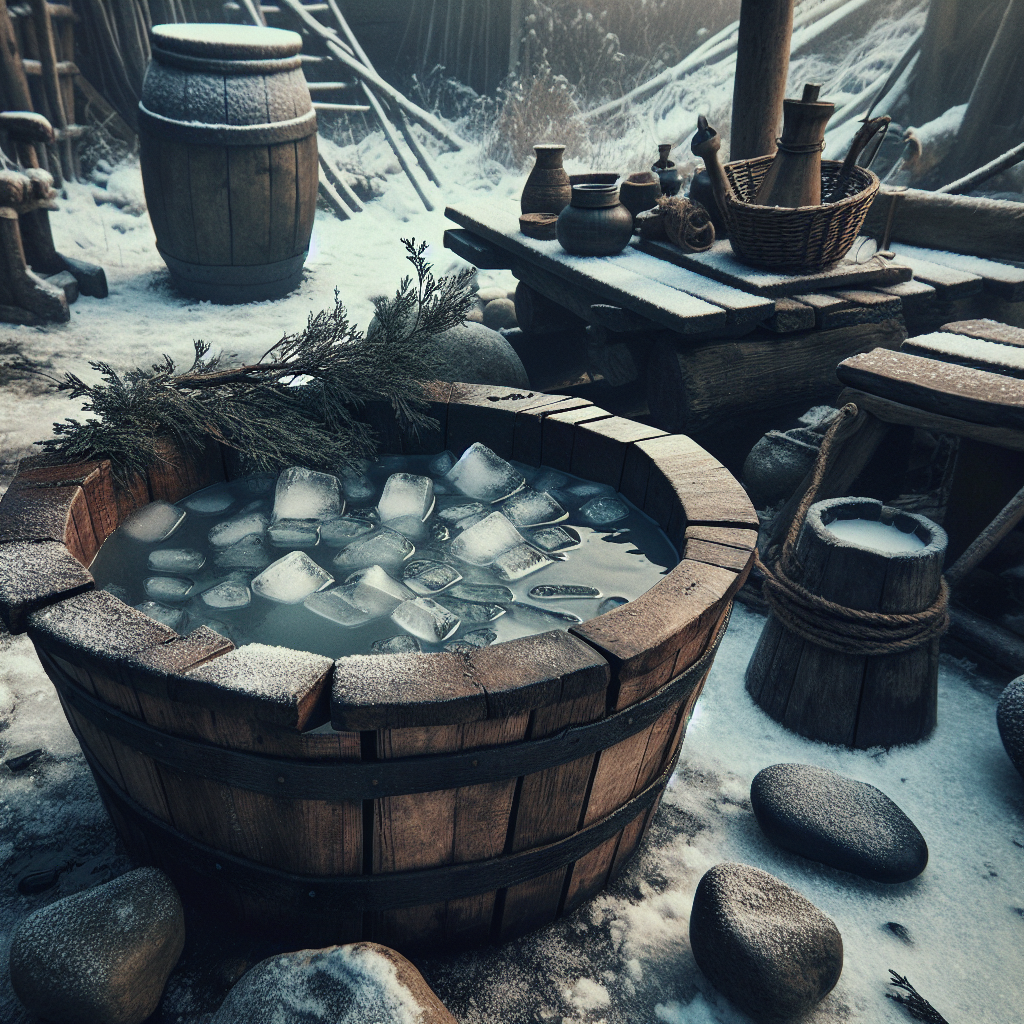Your journey into the history of ice bathing is about to begin. This fascinating read will allow you to trace its path from a sacred ritual of our ancestors, through medical practices of the past, right up to its position in contemporary health and wellness circles. “The Evolution of Ice Bathing: From Ancient Ritual to Modern Practice” is a chronicle of the myriad ways people have utilized the chilling power of ice to invigorate, heal, and rejuvenate their bodies. Far from being a new-age fad, you’ll discover that ice bathing is rooted in traditions as old as humankind itself. Prepare to deepen your understanding and appreciation of this exhilarating wellness practice.

The Origins of Ice Bathing
Ice bathing is not a new trend. Its origin traces back to ancient times when humans discovered the therapeutic values of cold water. It’s impressive how an age-old practice managed to remain relevant through the passage of time and technological advancements.
Ancient cultures and ice baths
Ancient cultures across the globe adopted various forms of cold-water immersion for its invigorating qualities. The Egyptians, famed for their advanced understanding of health and wellness, used ice baths as part of their medicinal practices. The Roman bathhouses were also famous not only for their heated baths but also the chilling frigidarium. Similarly, the ancient Japanese tradition of ‘Misogi’ included standing under cold waterfalls to cleanse the body and spirit.
Ice bathing in religious rituals
Ice bathing had a spiritual connection as well, extending beyond its therapeutic values. Various religious ceremonies and rituals involved plunging into icy waters. For instance, followers of Shinto in Japan practiced ‘Misogi’ for spiritual purification. Even today, Orthodox Christians celebrate the Epiphany by taking a dip in frigid waters, symbolizing the baptism of Jesus in the River Jordan.
The Early Medical Uses of Ice Bathing
The therapeutic benefits of ice bathing were recognized early on in human history, with many ancient civilizations incorporating this practice into their medical repertoire.
The Greek and Roman fascination with cold therapies
The ancient Greeks and Romans were fascinated by the healing potential of cold therapies. The Greek physician Hippocrates, often dubbed the ‘father of modern medicine’, was a known advocate of cold water hydrotherapy. Similarly, Roman doctors often prescribed a regimen of alternating hot and cold baths as a form of treatment.
Ice baths in traditional Chinese medicine
Traditional Chinese medicine also references the use of cold therapies. Ancient Chinese scriptures mention ‘cold dew therapy’, which involved staying outdoors on chilly mornings to experience the therapeutic effects of cold, akin to an ice bath.
Ice Bathing in the Middle Ages
Even in the Middle Ages, the practice of ice bathing continued to thrive, incorporating a mix of medical applications and spiritual significance.
Ice baths and medieval medicine
Medieval physicians retained the Greek and Roman practice of using hydrotherapy for healing. Cold water baths were commonly used to treat fever and inflammation. There’s also evidence that doctors during this period prescribed ice baths to calm down patients suffering from mental disorders.
The Influence of Islamic medicine
During the Middle Ages, Islamic medicine profoundly influenced global healing practices. Muslim doctors, building on the medical wisdom from Greece, Egypt and India, utilized ice and cold water to treat various ailments. This knowledge eventually filtered into Europe through medical texts translated into Latin.
Ice Bathing in Renaissance Europe
The Renaissance era witnessed a renewed interest in ice bathing, largely due to the development of hydrotherapy and the influence of significant historical figures.
The rise of hydrotherapy
The medical field during the Renaissance saw a resurgence of hydrotherapy. Physicians across Europe advocated the use of water, both hot and cold, for therapeutic purposes. The importance of bathing in cold water for promoting good health was highlighted in medical treatises of the period.
The influence of Paracelsus
Paracelsus, a Swiss physician and alchemist in the 16th century, played a crucial role in promoting the medical benefits of cold water baths. He strongly believed in the body’s ability to heal itself and advocated exposure to cold as a means to stimulate this natural healing process.
Ice Bathing in the 19th Century
The Victorian era was a transformative period for ice bathing. The advent of refrigeration technology and widespread interest in natural health remedies fuelled the popularity of this ancient practice.
The development of refrigeration technology
The 19th century witnessed the rise of refrigeration technology. Ice delivery became a common service, and the availability of ice led to the popularity of ice baths at home. Ice was no longer a seasonal commodity, and this accessibility made it a common tool in most medical practices.
Ice bathing as a treatment for various ailments
Doctors in Victorian times recommended ice baths as a cure for various ailments ranging from hysteria to muscle stiffness. Many hydrotherapy centers or ‘water cure’ institutions sprang up, advocating the benefits of cold water baths for overall well-being.
The Scientific Understanding of Ice Bathing
In modern times, the practice of ice bathing has been backed by science. The discovery of cryotherapy and studies on the effects of cold exposure on the body have given this age-old practice scientific validation.
The discovery of cryotherapy
Cryotherapy, which literally means ‘cold therapy’, involves exposing the body to extremely cold temperatures for short periods. It was developed in the late 20th century and is now a widely accepted form of therapy for reducing inflammation, managing pain and aiding recovery.
The effects of cold exposure on the body
Scientific research has shown that cold exposure can have various physiological effects on the body. For instance, it can reduce inflammation, improve circulation, and even boost mood. Moreover, the ‘fight or flight’ response triggered by cold exposure can provide a rejuvenating rush of adrenaline.
The Modern Applications of Ice Bathing
Today, ice bathing has found a place in both athletic and therapeutic settings. From sports recovery to pain relief, the applications are widespread.
Ice baths in sports recovery
Many athletes swear by ice bathing as a recovery tool after intense workouts. Soaking in an ice bath can aid muscle repair, reduce inflammation and stiffness, and enhance overall recovery.
The use of cold immersion for pain relief
On the therapeutic side, cold immersion is widely used for pain relief. People with chronic pain disorders, such as fibromyalgia and arthritis, often find relief in ice baths.
The Rise in Popularity of Ice Bathing
In recent years, ice bathing has become a wellness trend, making headlines due to endorsements from celebrities and the proliferation of cryotherapy centers.
Celebrities and influencers promoting ice baths
From athletes to supermodels to actors, many celebrities and influencers are voicing the benefits they’ve experienced from ice bathing. This increased visibility has triggered a surge in interest, leading many people to try ice bathing in hopes of achieving similar results.
The trend of cryotherapy centers
Cryotherapy centers have been popping up around the country, offering services such as whole-body cryotherapy and localized cold treatments. These facilities have made it easy for anyone to experience the benefits of cold therapy in a controlled, safe environment.
Safety Considerations for Ice Bathing
While there are many benefits to ice bathing, caution is important. Understanding how to prevent complications such as hypothermia and frostbite and how to monitor duration and temperature are critical for safe ice bathing.
Preventing hypothermia and frostbite
Prolonged exposure to cold can lead to hypothermia, a dangerous drop in body temperature. Similarly, tissues can freeze, causing frostbite. It’s crucial to limit your time in the ice bath and make sure your body is adequately warmed afterwards.
Monitoring duration and temperature
Duration and temperature should be carefully monitored during ice bathing. For beginners, it’s recommended to start with shorter dips in milder temperatures and gradually build resilience. Always listen to your body and get out if you feel you’ve had enough.
The Future of Ice Bathing
Looking forward, the prospect of ice bathing is far from icy. With advancements in cryotherapy technology and the potential exploration of new medical and therapeutic uses, the future seems promising.
Advancements in cryotherapy technology
New developments in cryotherapy technology are making it more efficient and safer. Future innovations might make treatments more accessible, possibly even for home use.
Potential medical and therapeutic uses
Research is ongoing into the potential benefits of ice bathing in treating various medical conditions. The future may unveil new therapeutic uses of this age-old practice, from treating mental health disorders to boosting immune response.
The evolution of ice bathing from an ancient ritual to a modern wellness practice is a testament to the enduring appeal and value of this method. As we continue to explore the full range of benefits it offers, it appears ice bathing is here to stay.
